key CADILLAC ESCALADE ESV 2009 Owners Manual
[x] Cancel search | Manufacturer: CADILLAC, Model Year: 2009, Model line: ESCALADE ESV, Model: CADILLAC ESCALADE ESV 2009Pages: 602, PDF Size: 5.18 MB
Page 1 of 602
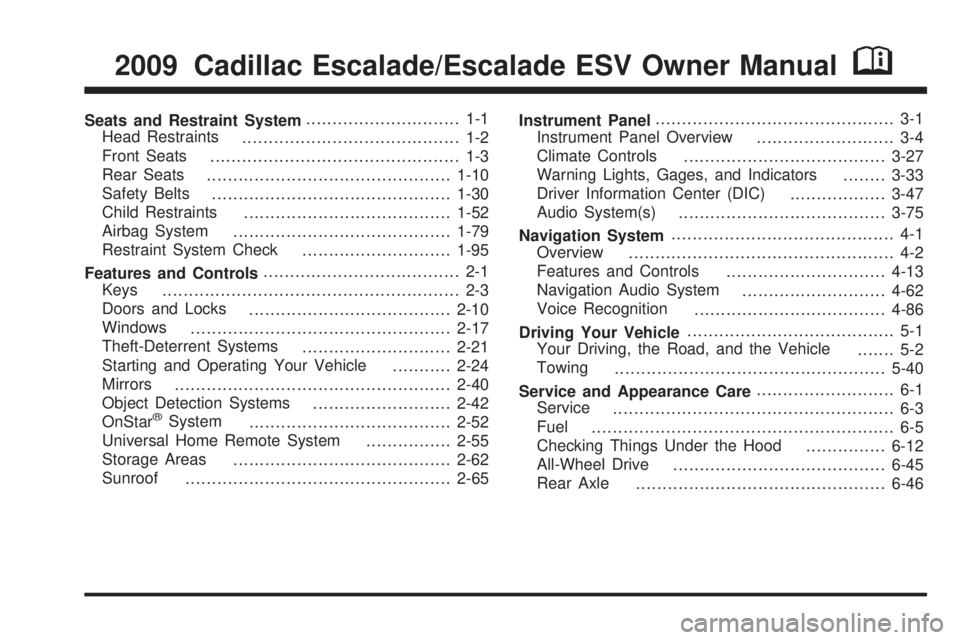
Seats and Restraint System ............................. 1-1
Head Restraints
......................................... 1-2
Front Seats
............................................... 1-3
Rear Seats
.............................................. 1-10
Safety Belts
............................................. 1-30
Child Restraints
....................................... 1-52
Airbag System
......................................... 1-79
Restraint System Check
............................ 1-95
Features and Controls ..................................... 2-1
Keys
........................................................ 2-3
Doors and Locks
...................................... 2-10
Windows
................................................. 2-17
Theft-Deterrent Systems
............................ 2-21
Starting and Operating Your Vehicle
........... 2-24
Mirrors
.................................................... 2-40
Object Detection Systems
.......................... 2-42
OnStar ®
System
...................................... 2-52
Universal Home Remote System
................ 2-55
Storage Areas
......................................... 2-62
Sunroof
.................................................. 2-65 Instrument Panel ............................................. 3-1
Instrument Panel Overview
.......................... 3-4
Climate Controls
...................................... 3-27
Warning Lights, Gages, and Indicators
........ 3-33
Driver Information Center (DIC)
.................. 3-47
Audio System(s)
....................................... 3-75
Navigation System .......................................... 4-1
Overview
.................................................. 4-2
Features and Controls
.............................. 4-13
Navigation Audio System
........................... 4-62
Voice Recognition
.................................... 4-86
Driving Your Vehicle ....................................... 5-1
Your Driving, the Road, and the Vehicle
....... 5-2
Towing
................................................... 5-40
Service and Appearance Care .......................... 6-1
Service
..................................................... 6-3
Fuel
......................................................... 6-5
Checking Things Under the Hood
............... 6-12
All-Wheel Drive
........................................ 6-45
Rear Axle
............................................... 6-462009 Cadillac Escalade/Escalade ESV Owner Manual
M
Page 13 of 602

Memory Features Your vehicle has the memory package.
The controls for this feature
are located on the driver’s
door, and are used to
program and recall memory
settings for the driver’s
seat, outside mirrors,
steering wheel position,
and the adjustable throttle
and brake pedal feature,
if your vehicle has it.
To save your positions in memory, do the following:
1. Adjust the driver’s seat, including the seatback
recliner and lumbar, both outside mirrors, steering
wheel, and the throttle and brake pedals to a
comfortable position.
See Outside Power Foldaway Mirrors on page 2-40
and Adjustable Throttle and Brake Pedal on
page 2-27 for more information.
Not all mirrors will have the ability to save and recall
the mirror positions.
2. Press and hold button 1 until two beeps let you know
that the position has been stored. A second seating, mirror, steering wheel position, and
throttle and brake pedal position can be programmed by
repeating the above steps and pressing button 2.
To recall the memory positions, the vehicle must be in
P (Park). Press and release either button 1 or button 2
corresponding to the desired driving position. The
seat, outside mirrors, steering wheel position, and
adjustable throttle and brake pedals will move to the
position previously stored. You will hear a single beep.
If you use the remote keyless entry transmitter to
enter your vehicle and the remote recall memory feature
is on, automatic seat, mirror, steering wheel position,
and adjustable pedal movement will occur. See
“MEMORY SEAT RECALL” under DIC Vehicle
Customization on page 3-65 for more information.
To stop recall movement of the memory feature at any
time, press one of the power seat controls, memory
buttons, power mirror buttons, power tilt wheel control,
or adjustable pedal switch.
If something has blocked the driver’s seat and/or the
adjustable pedals while recalling a memory position, the
driver’s seat and/or the adjustable pedals recall may stop
working. If this happens, remove the obstruction and
press the appropriate function control for two seconds.
Then try recalling the memory position again by pressing
the appropriate memory button. If the memory position is
still not recalling, see your dealer/retailer for service.
1-7
Page 14 of 602
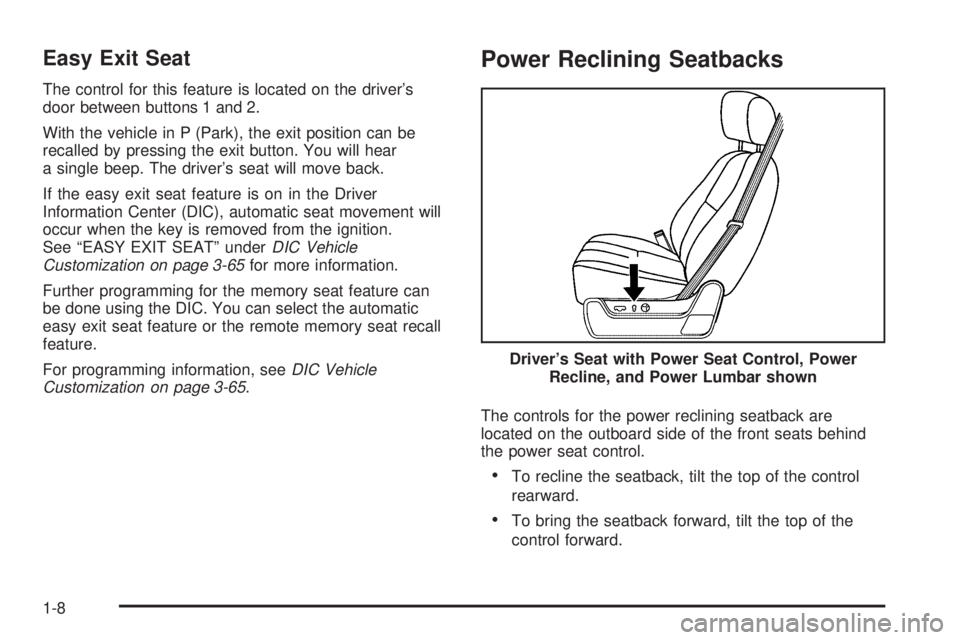
Easy Exit Seat The control for this feature is located on the driver’s
door between buttons 1 and 2.
With the vehicle in P (Park), the exit position can be
recalled by pressing the exit button. You will hear
a single beep. The driver’s seat will move back.
If the easy exit seat feature is on in the Driver
Information Center (DIC), automatic seat movement will
occur when the key is removed from the ignition.
See “EASY EXIT SEAT” under DIC Vehicle
Customization on page 3-65 for more information.
Further programming for the memory seat feature can
be done using the DIC. You can select the automatic
easy exit seat feature or the remote memory seat recall
feature.
For programming information, see DIC Vehicle
Customization on page 3-65 . Power Reclining Seatbacks
The controls for the power reclining seatback are
located on the outboard side of the front seats behind
the power seat control.
To recline the seatback, tilt the top of the control
rearward.
To bring the seatback forward, tilt the top of the
control forward.Driver’s Seat with Power Seat Control, Power
Recline, and Power Lumbar shown
1-8
Page 56 of 602
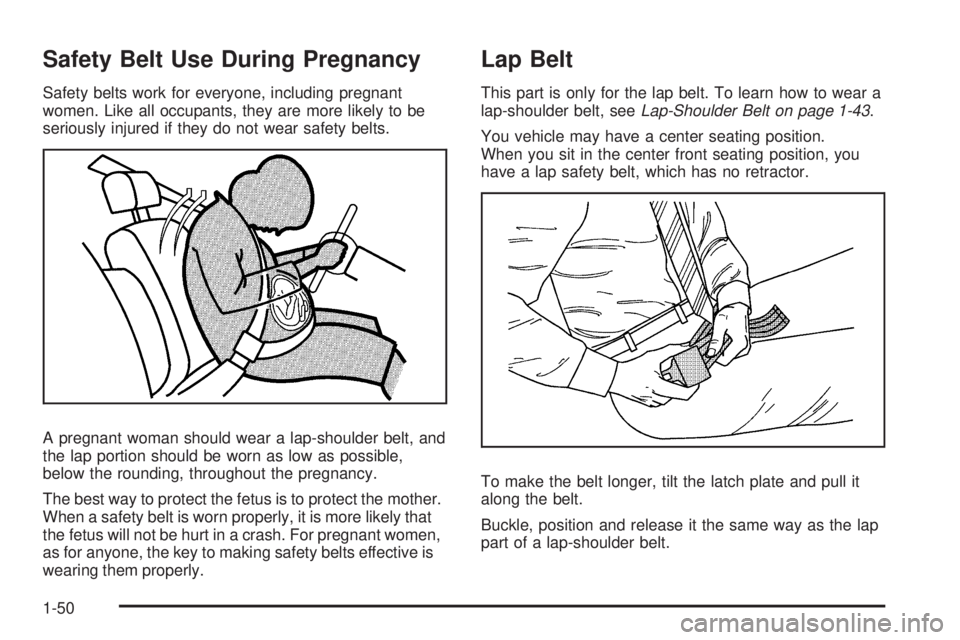
Safety Belt Use During Pregnancy Safety belts work for everyone, including pregnant
women. Like all occupants, they are more likely to be
seriously injured if they do not wear safety belts.
A pregnant woman should wear a lap-shoulder belt, and
the lap portion should be worn as low as possible,
below the rounding, throughout the pregnancy.
The best way to protect the fetus is to protect the mother.
When a safety belt is worn properly, it is more likely that
the fetus will not be hurt in a crash. For pregnant women,
as for anyone, the key to making safety belts effective is
wearing them properly. Lap Belt This part is only for the lap belt. To learn how to wear a
lap-shoulder belt, see Lap-Shoulder Belt on page 1-43 .
You vehicle may have a center seating position.
When you sit in the center front seating position, you
have a lap safety belt, which has no retractor.
To make the belt longer, tilt the latch plate and pull it
along the belt.
Buckle, position and release it the same way as the lap
part of a lap-shoulder belt.
1-50
Page 103 of 602
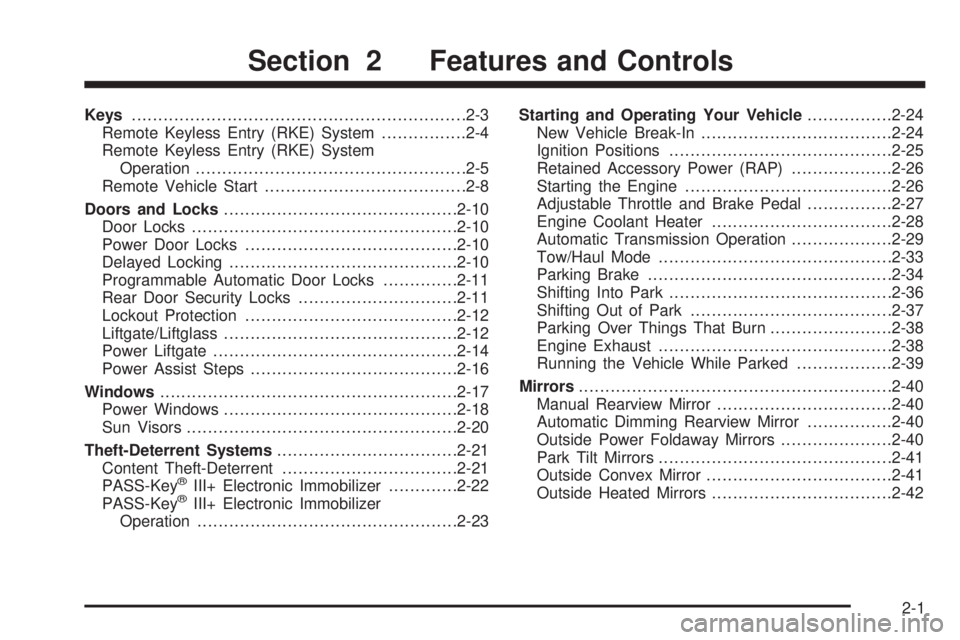
Keys .............................................................. .2-3
Remote Keyless Entry (RKE) System ............... .2-4
Remote Keyless Entry (RKE) System
Operation .................................................. .2-5
Remote Vehicle Start ..................................... .2-8
Doors and Locks ........................................... .2-10
Door Locks ................................................. .2-10
Power Door Locks ....................................... .2-10
Delayed Locking .......................................... .2-10
Programmable Automatic Door Locks ............. .2-11
Rear Door Security Locks ............................. .2-11
Lockout Protection ....................................... .2-12
Liftgate/Liftglass ........................................... .2-12
Power Liftgate ............................................. .2-14
Power Assist Steps ...................................... .2-16
Windows ....................................................... .2-17
Power Windows ........................................... .2-18
Sun Visors .................................................. .2-20
Theft-Deterrent Systems ................................. .2-21
Content Theft-Deterrent ................................ .2-21
PASS-Key ®
III+ Electronic Immobilizer ............ .2-22
PASS-Key ®
III+ Electronic Immobilizer
Operation ................................................ .2-23 Starting and Operating Your Vehicle ............... .2-24
New Vehicle Break-In ................................... .2-24
Ignition Positions ......................................... .2-25
Retained Accessory Power (RAP) .................. .2-26
Starting the Engine ...................................... .2-26
Adjustable Throttle and Brake Pedal ............... .2-27
Engine Coolant Heater ................................. .2-28
Automatic Transmission Operation .................. .2-29
Tow/Haul Mode ........................................... .2-33
Parking Brake ............................................. .2-34
Shifting Into Park ......................................... .2-36
Shifting Out of Park ..................................... .2-37
Parking Over Things That Burn ...................... .2-38
Engine Exhaust ........................................... .2-38
Running the Vehicle While Parked ................. .2-39
Mirrors .......................................................... .2-40
Manual Rearview Mirror ................................ .2-40
Automatic Dimming Rearview Mirror ............... .2-40
Outside Power Foldaway Mirrors .................... .2-40
Park Tilt Mirrors ........................................... .2-41
Outside Convex Mirror .................................. .2-41
Outside Heated Mirrors ................................. .2-42Section 2 Features and Controls
2-1
Page 105 of 602
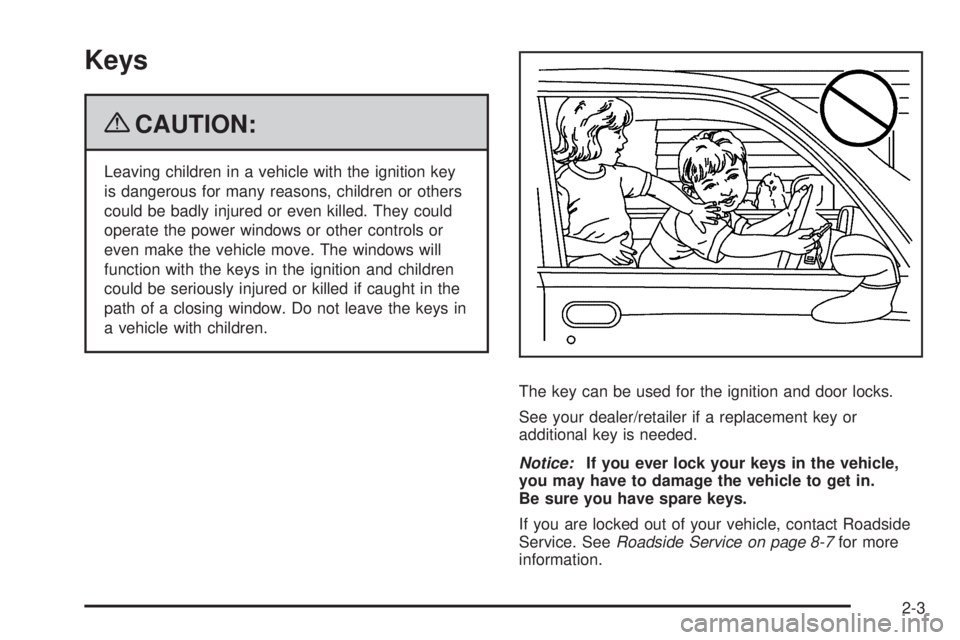
Keys
{ CAUTION: Leaving children in a vehicle with the ignition key
is dangerous for many reasons, children or others
could be badly injured or even killed. They could
operate the power windows or other controls or
even make the vehicle move. The windows will
function with the keys in the ignition and children
could be seriously injured or killed if caught in the
path of a closing window. Do not leave the keys in
a vehicle with children.
The key can be used for the ignition and door locks.
See your dealer/retailer if a replacement key or
additional key is needed.
Notice: If you ever lock your keys in the vehicle,
you may have to damage the vehicle to get in.
Be sure you have spare keys.
If you are locked out of your vehicle, contact Roadside
Service. See Roadside Service on page 8-7 for more
information.
2-3
Page 106 of 602
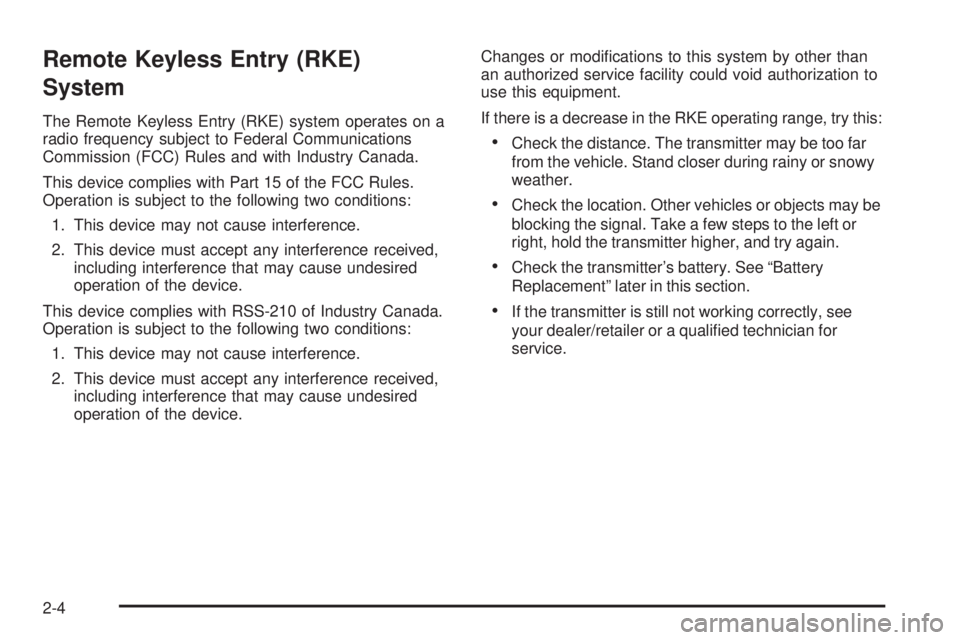
Remote Keyless Entry (RKE)
System The Remote Keyless Entry (RKE) system operates on a
radio frequency subject to Federal Communications
Commission (FCC) Rules and with Industry Canada.
This device complies with Part 15 of the FCC Rules.
Operation is subject to the following two conditions:
1. This device may not cause interference.
2. This device must accept any interference received,
including interference that may cause undesired
operation of the device.
This device complies with RSS-210 of Industry Canada.
Operation is subject to the following two conditions:
1. This device may not cause interference.
2. This device must accept any interference received,
including interference that may cause undesired
operation of the device. Changes or modi�cations to this system by other than
an authorized service facility could void authorization to
use this equipment.
If there is a decrease in the RKE operating range, try this:
Check the distance. The transmitter may be too far
from the vehicle. Stand closer during rainy or snowy
weather.
Check the location. Other vehicles or objects may be
blocking the signal. Take a few steps to the left or
right, hold the transmitter higher, and try again.
Check the transmitter’s battery. See “Battery
Replacement” later in this section.
If the transmitter is still not working correctly, see
your dealer/retailer or a quali�ed technician for
service.
2-4
Page 107 of 602
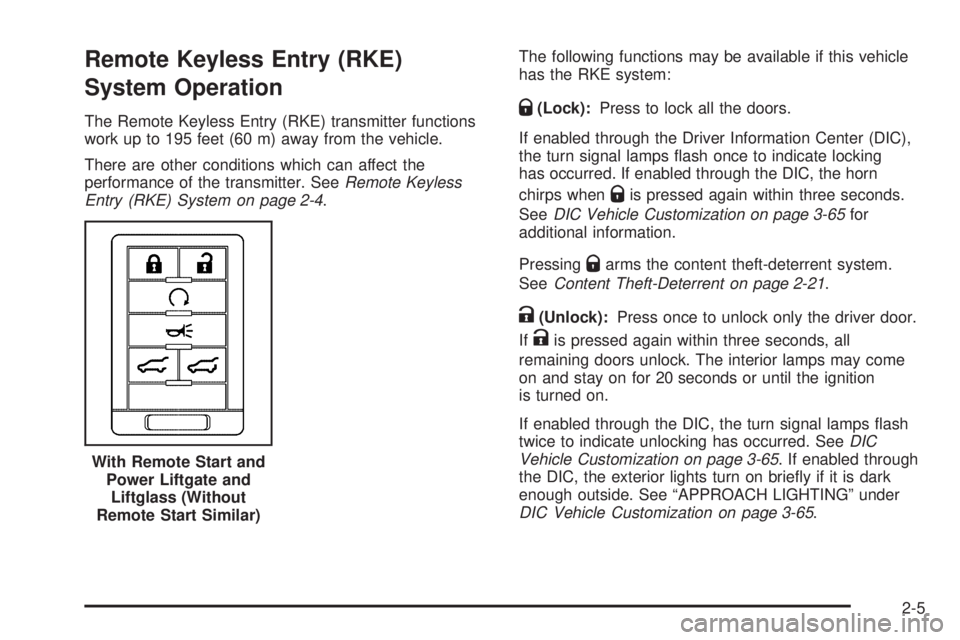
Remote Keyless Entry (RKE)
System Operation The Remote Keyless Entry (RKE) transmitter functions
work up to 195 feet (60 m) away from the vehicle.
There are other conditions which can affect the
performance of the transmitter. See Remote Keyless
Entry (RKE) System on page 2-4 . The following functions may be available if this vehicle
has the RKE system:
Q (Lock): Press to lock all the doors.
If enabled through the Driver Information Center (DIC),
the turn signal lamps �ash once to indicate locking
has occurred. If enabled through the DIC, the horn
chirps when
Q is pressed again within three seconds.
See DIC Vehicle Customization on page 3-65 for
additional information.
Pressing
Q arms the content theft-deterrent system.
See Content Theft-Deterrent on page 2-21 .
K (Unlock): Press once to unlock only the driver door.
If
K is pressed again within three seconds, all
remaining doors unlock. The interior lamps may come
on and stay on for 20 seconds or until the ignition
is turned on.
If enabled through the DIC, the turn signal lamps �ash
twice to indicate unlocking has occurred. See DIC
Vehicle Customization on page 3-65 . If enabled through
the DIC, the exterior lights turn on brie�y if it is dark
enough outside. See “APPROACH LIGHTING” under
DIC Vehicle Customization on page 3-65 .With Remote Start and
Power Liftgate and
Liftglass (Without
Remote Start Similar)
2-5
Page 108 of 602
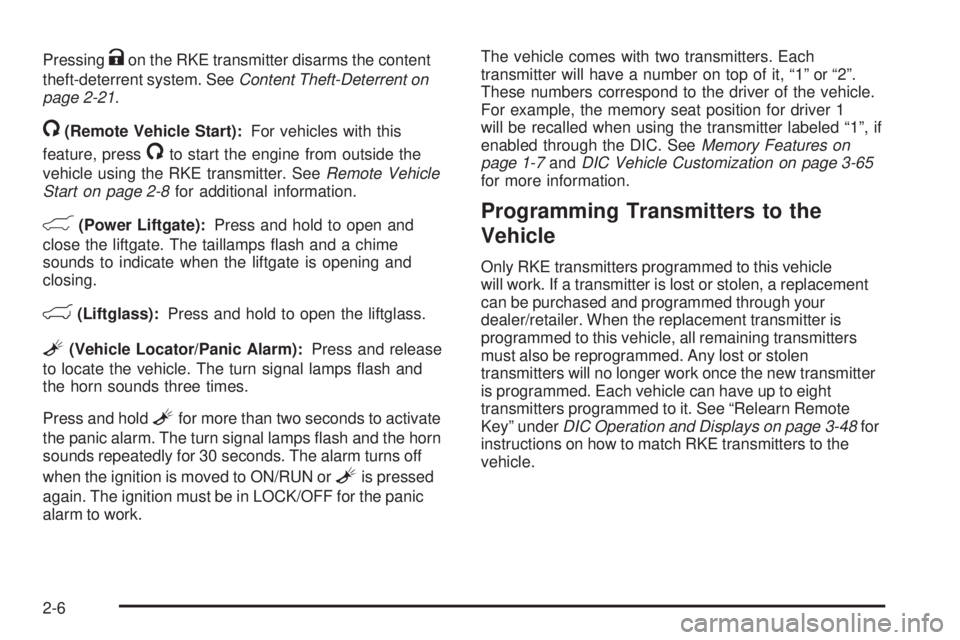
Pressing
K on the RKE transmitter disarms the content
theft-deterrent system. See Content Theft-Deterrent on
page 2-21 .
/ (Remote Vehicle Start): For vehicles with this
feature, press
/ to start the engine from outside the
vehicle using the RKE transmitter. See Remote Vehicle
Start on page 2-8 for additional information.
& (Power Liftgate): Press and hold to open and
close the liftgate. The taillamps �ash and a chime
sounds to indicate when the liftgate is opening and
closing.
m (Liftglass): Press and hold to open the liftglass.
L (Vehicle Locator/Panic Alarm): Press and release
to locate the vehicle. The turn signal lamps �ash and
the horn sounds three times.
Press and hold
L for more than two seconds to activate
the panic alarm. The turn signal lamps �ash and the horn
sounds repeatedly for 30 seconds. The alarm turns off
when the ignition is moved to ON/RUN or
L is pressed
again. The ignition must be in LOCK/OFF for the panic
alarm to work. The vehicle comes with two transmitters. Each
transmitter will have a number on top of it, “1” or “2”.
These numbers correspond to the driver of the vehicle.
For example, the memory seat position for driver 1
will be recalled when using the transmitter labeled “1”, if
enabled through the DIC. See Memory Features on
page 1-7 and DIC Vehicle Customization on page 3-65
for more information.
Programming Transmitters to the
Vehicle Only RKE transmitters programmed to this vehicle
will work. If a transmitter is lost or stolen, a replacement
can be purchased and programmed through your
dealer/retailer. When the replacement transmitter is
programmed to this vehicle, all remaining transmitters
must also be reprogrammed. Any lost or stolen
transmitters will no longer work once the new transmitter
is programmed. Each vehicle can have up to eight
transmitters programmed to it. See “Relearn Remote
Key” under DIC Operation and Displays on page 3-48 for
instructions on how to match RKE transmitters to the
vehicle.
2-6
Page 109 of 602
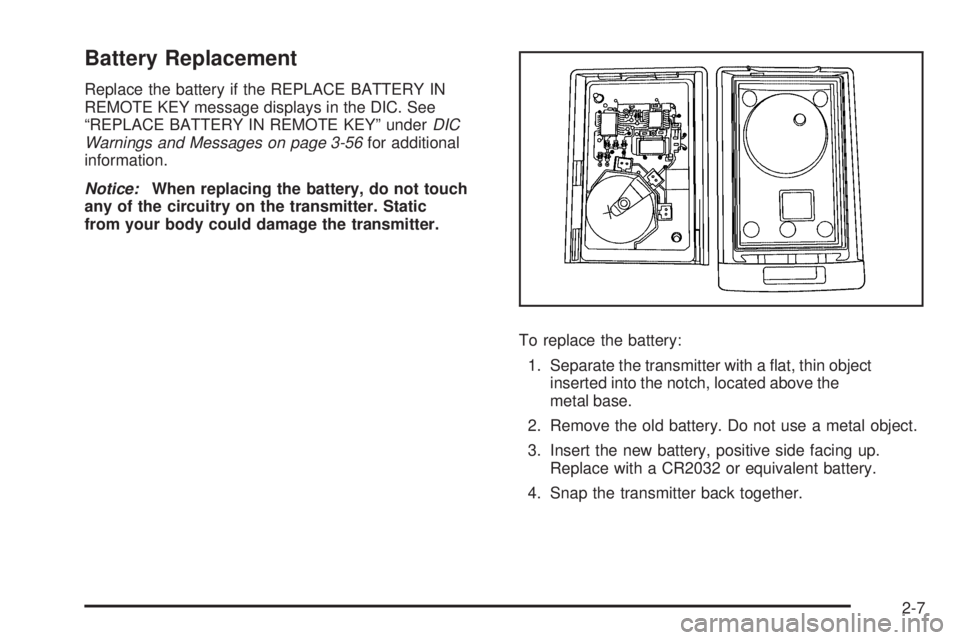
Battery Replacement Replace the battery if the REPLACE BATTERY IN
REMOTE KEY message displays in the DIC. See
“REPLACE BATTERY IN REMOTE KEY” under DIC
Warnings and Messages on page 3-56 for additional
information.
Notice: When replacing the battery, do not touch
any of the circuitry on the transmitter. Static
from your body could damage the transmitter.
To replace the battery:
1. Separate the transmitter with a �at, thin object
inserted into the notch, located above the
metal base.
2. Remove the old battery. Do not use a metal object.
3. Insert the new battery, positive side facing up.
Replace with a CR2032 or equivalent battery.
4. Snap the transmitter back together.
2-7